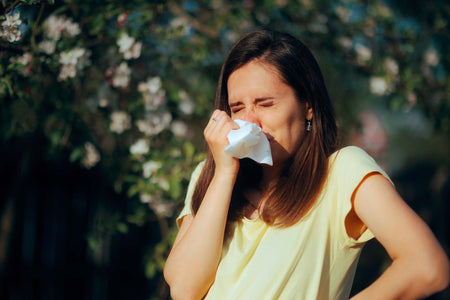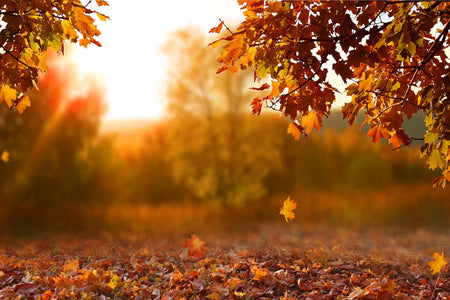- Pollen can be a significant allergen for many people and can trigger symptoms like sneezing, itchy and watery eyes, and runny nose when inhaled.
- Pollen comes from various types of plants such as grasses, trees or weeds, each with its own seasonal patterns.
- Awareness of pollen seasons allows you to plan outdoor activities and take preventive measures.
Pollen particles can be the culprit behind many seasonal allergies, and they fluctuate throughout the year based on weather, location, and the changing seasons. If you’re planning ahead to avoid potential symptoms, you need to know what to expect each month. This can help you better manage your allergies.
This article will provide a month-by-month breakdown of typical pollen patterns so that you can enjoy each season to the fullest.
What is Pollen?
Pollen is a fine, powdery substance produced by plants, consisting of microscopic grains that contain male gametes required for plant reproduction. Each grain is rich in proteins and is designed to fertilize female plant structures to produce seeds.
While needed for plant reproduction, pollen can become an allergen for humans. It can trigger symptoms like sneezing, itching, and nasal congestion when inhaled or exposed to allergic individuals.
Research shows that pollen grains are typically too large to reach the lower parts of the respiratory tract, such as the thoracic region (the area of the lungs). Instead, they mainly affect the nasopharyngeal mucous membranes, which are located in the nose and throat. This can cause the above-mentioned symptoms [*].
However, there are also smaller pollen particles, known as submicronic pollen particles, that can be small enough to be inhaled deeply into the upper airways. These smaller particles can reach the respiratory system more deeply and may contribute to the worsening of conditions like asthma and other allergic reactions.
When Does Pollen Season Start?
The exact timing of pollen season can vary depending on geographic location and local climate conditions.
Pollen season typically begins in early spring, around March, as trees start to release their pollen. This season can last until June. As spring progresses, grass pollen becomes more prevalent. Grass pollen season usually peaks in late spring to early summer, around May to July, depending on the region.
In warmer regions, such as the southern United States, tree pollen can start earlier, even in late winter. Weed pollen season starts in the late summer and can extend into the late fall in many geographies.
When Does Pollen Season End?
Pollen season typically ends when the primary pollen types for the year, such as tree, grass, or weed pollen, are no longer actively released by plants - usually once temperatures get cold and winter sets in.
Tree pollen usually subsides by late spring, grass pollen fades by late summer, and weed pollen can continue into fall.
In regions with milder climates such as the Western and Southern areas of the United States, some types of pollen may persist longer, even year-round, but generally, pollen levels drop with cooler temperatures and increased precipitation, which help to clear the air of pollen.
Types of Pollen By Season
Since pollen types vary by season, allergy symptoms can be present different times of the year. Here’s a breakdown of the common types of pollen by season:
Spring
In spring, tree pollen is the primary allergen, and this marks the beginning of allergy season for many people.
Here's a breakdown of pollen by month:
- March: This is when tree pollen typically begins to emerge, especially in regions with milder winters. Examples of trees releasing pollen in March include birch, oak, elm, maple, and cedar.
- April: This is often the peak month for tree pollen, with many trees fully active in releasing pollen. In addition to the trees mentioned above, other trees like ash, sycamore, and walnut may also contribute to pollen levels. In some regions, grass pollen might start to appear late in the month, although it usually remains low compared to tree pollen.
- May: Tree pollen levels may begin to decline towards the end of May, but can still be significant. Grass pollen levels start to rise in May, which marks the beginning of the grass pollen season. Common grasses include Kentucky bluegrass, ryegrass, and timothy grass.
- June: By June, tree pollen levels typically decrease. Meanwhile, there are high levels of grass pollen in the air, especially in temperate climates.
Related: Grass Rash: Causes, Symptoms, and Treatment
Summer
During the summer months, pollen from grasses typically dominates. Some weed pollen starts to emerge later in the season.
Here's a breakdown of pollen by month:
- June: This is often the peak month for grass pollen. Common grasses that increase pollen levels include timothy grass, ryegrass, and Bermuda grass. Tree pollen levels generally taper off, especially in regions where spring ends earlier.
- July: By mid-July, grass pollen levels may begin to decline as the summer progresses, but they can still be significant. Early-emerging weed pollen may start to appear in July, particularly from weeds like plantain and lamb's quarters. However, weed pollen levels are generally low.
- August: Grass pollen levels typically decrease, especially in regions where summer heat has set in. This also marks the beginning of the weed pollen season, with ragweed being the most notorious. Ragweed pollen can travel long distances and is a common trigger for late-summer allergies.
Fall
This pollen season typically starts in late summer and continues into fall, with ragweed being one of the most significant culprits due to its abundant and potent pollen.
Here's a breakdown of pollen by month:
- September: This is typically the peak month for weed pollen, especially ragweed. Ragweed pollen can be extremely potent and travels great distances, which causes widespread allergic reactions. In some regions, grass pollen may still be present in early September, but it usually declines as the month progresses.
- October: Ragweed begins to decrease in October as the weather cools. Other weeds like nettle and chenopods may also contribute to pollen levels. Although not pollen, it’s worth noting that mold spores often become more prevalent in October due to fallen leaves and decaying vegetation.
- November: By November, weed pollen levels typically drop significantly in most regions due to cooler temperatures and frost. Mold spores may still be a concern in November, particularly in areas with damp or decaying leaves.
Winter
While winter is less known for high pollen counts, indoor allergens such as dust mites, mold, and pet dander can become more problematic as people spend more time indoors.
Here's a breakdown of pollen by month:
- December: In most regions, pollen levels are at their lowest in December due to cold temperatures and dormancy of most plants. However, in warmer climates some early-blooming trees, like cedar or juniper, may begin to release pollen late in the month.
- January: Trees like cedar, juniper, alder, and elm may begin to release pollen. Cedar fever, a condition caused by mountain cedar pollen, is particularly common in areas like Texas.
How to Prepare for Pollen Season
If you’re prone to allergies, preparing for pollen season can make a big difference. Here are some tips to help you manage:
- Monitor pollen counts. For people with seasonal allergies, local pollen forecasts help them anticipate when pollen levels will be high. Keep an eye on these forecasts so you can prioritize staying indoors on days when counts are high.
- Keep windows closed. When windows are open, pollen particles in the air can easily enter your home, settling on surfaces like furniture, floors, and bedding. Keep windows closed during high pollen times, especially in the morning when counts are usually highest.
- Use air purifiers. While HEPA filters are highly effective at capturing small particles, including pollen, dust, and pet dander, not all air purifiers use them. Consider using air purifiers with HEPA filters to reduce indoor pollen levels. Make sure to clean or replace filters regularly.
- Wash bedding and clothes. Pollen can cling to clothing, hair, and bedding. Wash your clothes after each wear, and sheets and pillow cases every 3-4 days.
- Shower and change clothes. After spending time outdoors, shower and change into clean clothes to remove pollen that may have collected on your skin and hair.
- Avoid outdoor activities. On high pollen days, try to limit your outdoor activities. If you need to go outside, try to do so later in the day when pollen counts tend to drop.
- Keep pets clean. Pets can bring pollen indoors on their fur. Bathe them regularly and keep them out of bedrooms.
- Use allergy medications. If you take allergy medications, start them before pollen season begins to get ahead of symptoms [*]. This applies to nasal sprays as well, which can prevent symptoms from developing or make them less severe when pollen levels rise. Allermi nasal spray contains more than one ingredient for comprehensive symptom relief.
Related: Spring Cleaning Checklist
Frequently Asked Questions
Here are some frequently asked questions about pollen season:
What are the main types of pollen?
The main types of pollen that cause allergies are tree pollen, grass pollen, and weed pollen. Tree pollen includes sources like oak, birch, cedar, maple, pine, elm, ash, alder, and juniper. Grass pollen includes sources like bermuda grass, Timothy grass, Kentucky bluegrass, ryegrass, and fescue. Weed pollen includes sources like ragweed, sagebrush, pigweed, lamb’s quarters, and nettle.
What are the peak times for pollen release?
Pollen release usually peaks early in the morning, from around 5 to 10 a.m., and again in the late afternoon to early evening. These times correspond to periods of warmer temperatures and increased wind, which help disperse the pollen.
What are the worst months for pollen?
Generally, tree pollen is highest in early spring (March to May), grass pollen peaks from late spring to summer (May to July), and weed pollen is most problematic from late summer to fall (August to October). Checking local pollen forecasts can provide more precise information for your area.
When pollen particles come into contact with the eyes, they can cause an allergic reaction, causing symptoms such as itchy and watery eyes.
The Bottom Line
Knowing the specific pollen seasons can help you and your loved ones make informed decisions about outdoor activities, travel, and even home maintenance.
Follow this pollen season guide to reduce your exposure to allergens, and update your allergy management plan based on anticipated pollen levels.
References:
- Ravindra, K., Goyal, A., & Mor, S. (2022). Pollen allergy: Developing multi-sectorial strategies for its prevention and control in lower and middle-income countries. International Journal of Hygiene and Environmental Health, 242, 113951. https://doi.org/10.1016/j.ijheh.2022.113951
- D’Amato, G., Murrieta-Aguttes, M., D’Amato, M., & Ansotegui, I. J. (2023). Pollen respiratory allergy: Is it really seasonal? World Allergy Organization Journal, 16(7), 100799. https://doi.org/10.1016/j.waojou.2023.100799









